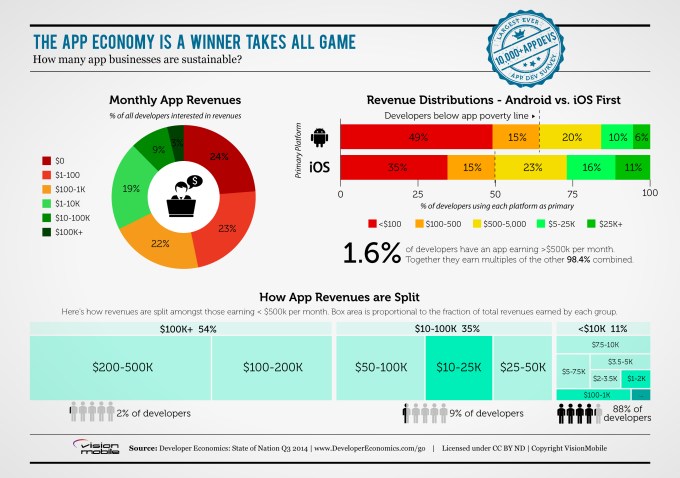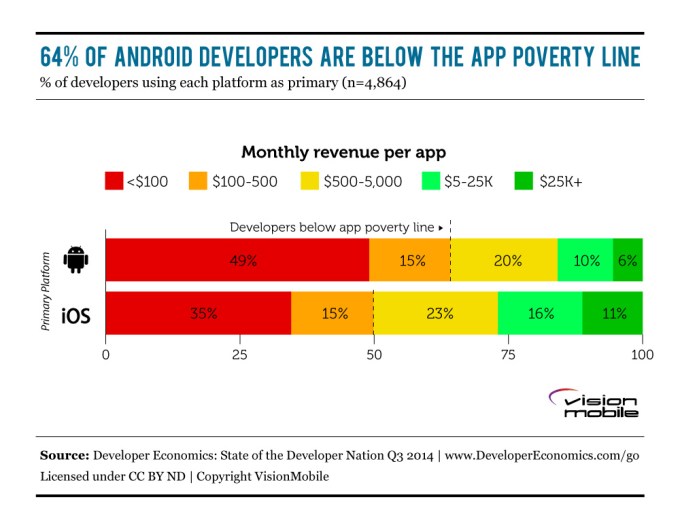Though the app stores continue to fill up with ever more mobile applications, the reality is that most of these are not sustainable businesses. According to a new report out this morning, half (50%) of iOS developers and even more (64%) Android developers are operating below the “app poverty line” of $500 per app per month.
This detail was one of many released in VisionMobile’s latest Developer Economics report (for Q3 2014), which was based on a large-scale online developer survey and one-to-one interviews with mobile app developers. This report included the responses from over 10,000 developers from 137 countries worldwide, taking place over 5 weeks in April and May.
That mobile app developers are challenged in getting their apps discovered, downloaded and then actually used, is a well-known fact. But seeing the figures associated with exactly how tough it is out there is rather revealing. It seems the “1%” is not only a term applicable to the economy as a whole – it’s also taking place within the app store economy, too.
The report’s authors detail the specifics around the trend where a tiny fraction of developers – actually, it’s 1.6% to be exact – generate most of the app store revenue. Slyly referencing the “disappearing middle class of app developers,” the report’s analysis groups the estimated 2.9 million mobile app developers worldwide into a handful of different categories for easy reference: the “have-nothings,” the “poverty-stricken,” the “strugglers,” and the “haves.” And, as you can tell, most of these categories don’t sound too great.

Have Nothings
Accounting for 47% of app developers, the “have nothings” include the 24% of app developers – who are interested in making money, it should be noted – who make nothing at all.
Meanwhile, 23% make something, but it’s under $100 per month. These developers are sometimes unable to cover the basic costs of development PCs, test devices, and an account to publish apps, the report states. However, in case you’re wondering why so many developers still go iOS first, it’s because those who prioritize iOS app development are less likely to find themselves in this group, with 35% earning $0-$100 per month, versus the 49% of Android developers.
There’s also a portion of the app developer population (35%), some of whom aren’t interested in making money. The report refers to these part-timers as “hobbyists” or “explorers,” who may be just testing the waters, or working on apps that have yet to launch. Still, more than half of this crowd is interested in making some money from their applications, while less than half make $0 per month.
Poverty Stricken & Strugglers
Meanwhile, 22% are “poverty stricken” developers whose apps make $100 to $1,000 per app per month. At this rate, the companies behind the apps couldn’t afford standard app developer salaries. 15% of developers make between $100-$500 per app per month and 7% make between $500-$1,000 per app per month.
When combined with the above “have nots,” that means 62% of developers are below the “app poverty line” of $500 per app per month, and some 69% can’t sustain full-time development.

The “strugglers” are a bit more fortunate. 19% of developers earn $1,000 to $10,000 per app per month, which could either be a supplement to full-time work or even a something of a good living, if in the high-end of that band. But these apps also tend to be more complex, requiring more development effort, and possibly ongoing server costs which can cut into the developer’s bottom line.
Winner Takes All: The “Haves”
Finally, there are the “haves.” The top 12% make more than $10,000 per app per month. 17% of iOS-first developers are in this group versus 9% of Android-first developers. To give you a sense of this group’s members: a rank-100 grossing game on iOS in the U.S. would expect to make $10,000 per day.
However, states the report, only the top 1.6% of developers make more than $500,000 per app per month, but of those who do, some are earning tens of millions per month. The next 2% – those who make between $100,000 and $500,000 per month – are making more than 96.4% of the rest of the app developers out there.
“More than 50% of app businesses are not sustainable at current revenue levels, even if we exclude the part-time developers that don’t need to make any money to continue,” states the report. “A massive 60-70% may not be sustainable long-term, since developers with in-demand skills will move on to more promising opportunities.”
As Apps Disappear, Will They Be Seen As Disposable?
The interesting thing about these numbers, besides just indicating how hard it is to have an app really hit big, is that the market economics are actually encouraging developers and users alike to see most apps as disposable things, not businesses you remain committed to long-term.
These days, many mobile app startups look more like resumés for developers who will soon abandon their work following acqui-hire M&A deals. And the continuous exits and new launches – where some startups are even being scooped up pre-launch – are creating an app consumer user base which thinks of apps as things that will quickly disappear (if you’re not Facebook, I suppose).
That makes it harder for many users today to buy into claims that an app wants to be your go-to home for important, lasting communications – like messaging clients aimed at businesses or the apps that want to store all your precious photo memories. And of course, most games have limited life-spans, too.
But on the flip side, today’s younger consumers are wired differently from their Gen X or Y (and older) counterparts. They’re fine with impermanent messages, deleting their social media accounts at will, data loss be damned. This group of consumers is an ideal audience for the increasingly disposable nature of mobile apps – at least while the current consumer app gold rush continues.
